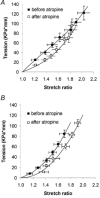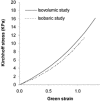Effect of atropine on the biomechanical properties of the oesophageal wall in humans
- PMID: 12562937
- PMCID: PMC2342665
- DOI: 10.1113/jphysiol.2002.028795
Effect of atropine on the biomechanical properties of the oesophageal wall in humans
Abstract
Recently, we reported a novel ultrasound technique to assess biomechanical properties of the oesophagus in human subjects. In the present study, we use the technique, in combination with atropine, to determine the active and passive biomechanical properties of the oesophagus in normal healthy humans. A manometric catheter equipped with a high-compliance bag and a high-frequency intraluminal ultrasonography probe was used to record pressure and oesophageal geometry. Oesophageal distensions with either isovolumic (5-20 ml water) or with isobaric (10-60 mmHg) technique were performed. Intra-bag pressure and ultrasound images of the oesophagus were recorded simultaneously. Following injection of atropine (15 microg kg-1, I.V.), the oesophageal distensions were repeated. The oesophageal wall compliance, circumferential wall tension, stress, strain and elastic modulus were calculated. Atropine resulted in an increase in the oesophageal wall compliance during isobaric distension, but no change in compliance was observed during isovolumic distension. The stress-strain relationship was found to be linear during both types of distension, before as well as after atropine. The Young's modulus, which is the slope of a linear stress-strain relationship, was significantly higher after atropine in the isovolumic study but not in the isobaric study. The stress-strain relationship of the active component (muscle contraction) was different during isovolumic and isobaric distensions but the passive components were similar. The passive and active stress-strain relationships of the human oesophagus resemble those of other soft biological tissues. Furthermore, the method of oesophageal distension has significant influence on the active but not the passive biomechanical properties due to a strain-rate effect.
Figures






Similar articles
-
A novel ultrasound technique to study the biomechanics of the human esophagus in vivo.Am J Physiol Gastrointest Liver Physiol. 2002 May;282(5):G785-93. doi: 10.1152/ajpgi.00394.2001. Am J Physiol Gastrointest Liver Physiol. 2002. PMID: 11960775 Clinical Trial.
-
Oesophageal wall stretch: the stimulus for distension induced oesophageal sensation.Neurogastroenterol Motil. 2004 Dec;16(6):721-8. doi: 10.1111/j.1365-2982.2004.00620.x. Neurogastroenterol Motil. 2004. PMID: 15601421
-
Oesophageal wall stress and muscle hypertrophy in high amplitude oesophageal contractions.Neurogastroenterol Motil. 2005 Dec;17(6):791-9. doi: 10.1111/j.1365-2982.2005.00693.x. Neurogastroenterol Motil. 2005. PMID: 16336494 Clinical Trial.
-
The oesophageal zero-stress state and mucosal folding from a GIOME perspective.World J Gastroenterol. 2007 Mar 7;13(9):1347-51. doi: 10.3748/wjg.v13.i9.1347. World J Gastroenterol. 2007. PMID: 17457964 Free PMC article. Review.
-
Impedance planimetry: a new approach to biomechanical intestinal wall properties.Dig Dis. 1991;9(6):332-40. doi: 10.1159/000171320. Dig Dis. 1991. PMID: 1804574 Review.
Cited by
-
Three-dimensional surface model analysis in the gastrointestinal tract.World J Gastroenterol. 2006 May 14;12(18):2870-5. doi: 10.3748/wjg.v12.i18.2870. World J Gastroenterol. 2006. PMID: 16718811 Free PMC article. Review.
-
Ultrasonographic study of mechanosensory properties in human esophagus during mechanical distension.World J Gastroenterol. 2006 Jul 28;12(28):4517-23. doi: 10.3748/wjg.v12.i28.4517. World J Gastroenterol. 2006. PMID: 16874864 Free PMC article. Clinical Trial.
-
Dimensions and circumferential stress-strain relation in the porcine esophagus in vitro determined by combined impedance planimetry and high-frequency ultrasound.Dig Dis Sci. 2007 May;52(5):1338-44. doi: 10.1007/s10620-006-9238-6. Epub 2007 Mar 14. Dig Dis Sci. 2007. PMID: 17356919
-
Esophageal function testing: beyond manometry and impedance.Gastrointest Endosc Clin N Am. 2014 Oct;24(4):667-85. doi: 10.1016/j.giec.2014.06.006. Epub 2014 Aug 1. Gastrointest Endosc Clin N Am. 2014. PMID: 25216911 Free PMC article. Review.
-
Mechanical experimentation of the gastrointestinal tract: a systematic review.Biomech Model Mechanobiol. 2024 Feb;23(1):23-59. doi: 10.1007/s10237-023-01773-8. Epub 2023 Nov 8. Biomech Model Mechanobiol. 2024. PMID: 37935880 Free PMC article.
References
-
- Assentoft JE, Gregersen H, O'Brien WD. Determination of biomechanical properties in guinea pig oesophagus by means of high frequency ultrasound and impedance planimetry. Dig Dis Sci. 2000;45:1260–1266. - PubMed
-
- Barish CF, Richter JE, Blackwell JN, Castell DO. Pharmacologic testing of oesophageal muscle wall response to bag dilatation in primates. Gastroenterology. 1984;86:1020.
-
- Cox RH. Anisotropic properties of the canine carotid artery in vitro. J Biomech. 1975;8:293–300. - PubMed
-
- Dobrin PB. Biaxial anisotropy of dog carotid artery: estimation of circumferential elastic modulus. J Biomech. 1986;19:351–358. - PubMed
-
- Fung YC. Biomechanics. New York: Springer Verlag; 1993.
MeSH terms
Substances
LinkOut - more resources
Full Text Sources
Other Literature Sources

